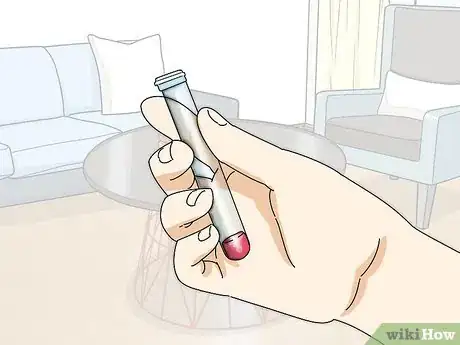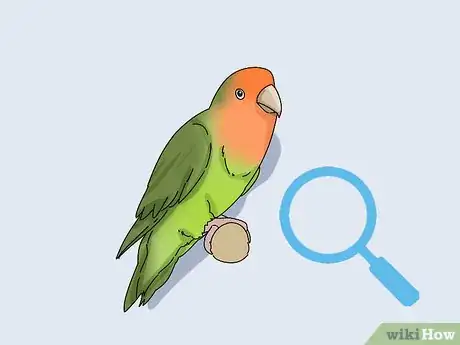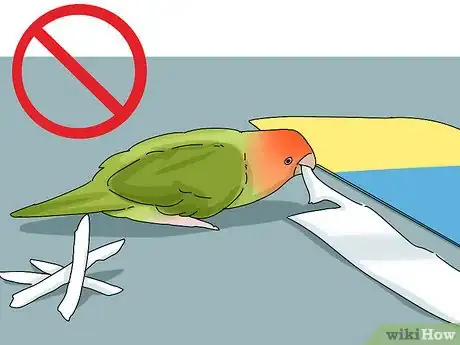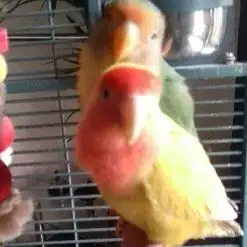This article was co-authored by Pippa Elliott, MRCVS. Dr. Elliott, BVMS, MRCVS is a veterinarian with over 30 years of experience in veterinary surgery and companion animal practice. She graduated from the University of Glasgow in 1987 with a degree in veterinary medicine and surgery. She has worked at the same animal clinic in her hometown for over 20 years.
There are 10 references cited in this article, which can be found at the bottom of the page.
wikiHow marks an article as reader-approved once it receives enough positive feedback. This article has 17 testimonials from our readers, earning it our reader-approved status.
This article has been viewed 388,304 times.
Lovebirds can be wonderful and endearing pets. They tend to have cute chatter and beautiful coloring, in addition to being very social creatures. However, most species that are kept as pets cannot be easily sexed. If you are interested in getting some lovebirds, but don't want them to breed, it is important that you figure out their sex before you put them in the same cage. If you don't, you could end up with more birds than you expected or wanted.
Steps
Determining the Sex With Physical Tests
-
1Give your lovebird a physical exam. If you are just curious about the sex of a lovebird, and are comfortable with the possibility of being wrong, a physical exam can give you some clues. For example, feeling the distance between the pelvic bones can help you determine the sex.[1]
- Female lovebirds need more width in the pelvic region in order to pass eggs through it. This means that you may be able to determine a male from a female by comparing the width of several lovebird's pelvic bones.
- Take the bird into your less-dominant hand so that it is held upside down and its head is away from you. Take the pointer and middle fingers of your dominant hand and gently feel around the pelvic area of the bird. You should be able to feel the pelvic bones through the feathers and skin.
- Then compare how one bird's pelvic bones feel compared to others. This is the only way you can determine which ones are wider.
-
2Get a blood test. The best and most conclusive way to find out a lovebird's sex is to get a blood test. Your bird's DNA will be examined in a lab and you will have a conclusive answer as to the sex of the bird.[2]
- There are online services that will test your bird's DNA. The company will send you a collection kit, you send it back to them after following their directions, and then they will send you the results.[3]
-
3Get your bird surgically sexed. With this procedure, the bird will be put under anesthesia, a small incision will be made in its abdomen, and the veterinarian will inspect its reproductive organs. This is an invasive procedure that is not usually suggested for pet birds. Instead, it is predominantly used by bird breeders.[4]
- Surgical sexing is usually cheaper than DNA sexing but it has many more downsides, such as the risk of illness and death associated with surgery.
- Once a bird is surgically sexed, a tattoo is usually applied to the bird to permanently mark it as male or female.
Avoiding Common Sexing Mistakes
-
1Determine if you have a breed of lovebird that has unique sex characteristics. Most lovebirds can't be sexed based on a visual examination. In fact, the most common type kept as a pet, the peach-faced lovebird, has to be DNA tested to truly determine the sex.[5] [6]
- Some people argue that female lovebirds are generally smaller than male lovebirds. This is only visible in certain breeds of lovebirds.
- Some people also assert that a female lovebird's feet are perched wider apart than a male's feet. This has to do with the assumption that a female's pelvis is wider than a male's.This depends on the species.
- Unlike many other types of birds, most types of lovebird coloring does not differ based on sex. There are some exceptions, however, such as the Madagascar lovebird. The male Madagascar lovebird has grey on its head, while the females are solidly colored green.[7]
-
2Do not rely on paper shredding and nest-building behavior to sex your bird. In general, when lovebirds are interested in mating they tend to shred paper, whether they are male or female. This seems to be true across species, with Fischer's and peach-faced lovebirds, for example, exhibiting the same behavior regardless of sex. [8] [9]
-
3Don't assume that a bonded pair of lovebirds are male and female. If lovebirds are kept in a pair, they tend to form an intense bond. It does not matter what the sex of the birds are. Birds kept together will become a unit. Bonded pairs of the same sex are even known to work on nesting together.[12]
References
- ↑ https://www.youtube.com/watch?v=mIJcJ4gqa0c
- ↑ http://www.parrotparrot.com/lovebirds/breeding-lovebirds/
- ↑ http://www.avianbiotech.com
- ↑ http://www.scottemcdonald.com/pdfs/Protocol%20Surgical%20Sexing.pdf
- ↑ http://www.smithsonianmag.com/science-nature/14-fun-facts-about-lovebirds-180949742/
- ↑ http://animals.mom.me/tell-male-female-lovebirds-6326.html
- ↑ http://animals.mom.me/tell-male-female-lovebirds-6326.html
- ↑ https://www.beautyofbirds.com/fischerslovebirds.html
- ↑ http://www.goodbirdinc.com/parrot-profiles-lovebird.html
About This Article
The best and most conclusive way to find out a lovebird's sex is to get a blood testing kit, which you can buy online. If you want to examine the bird yourself, hold it upside down in your non-dominant hand with its head pointing away from you. Next, use the fingers of your dominant hand to gently feel the pelvic bones through the feathers and skin. Since females need wider pelvic regions to pass eggs, you can compare the pelvises of several birds to figure out which ones are female. To learn more about using blood testing kits, read on!



































































